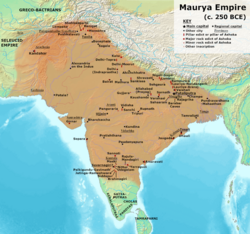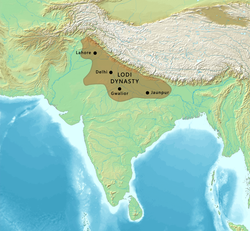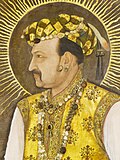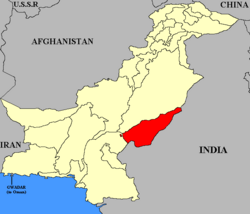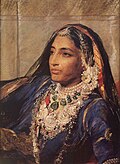| Maharaja of Punjab | |
|---|---|
Imperial | |
 Seal of Ranjit Singh | |
 | |
| Details | |
| Style | |
| First monarch | Udayana 6th century – 5th century BC (first known ruler) |
| Last monarch | Duleep Singh 1843–1849 (as Maharaja of Punjab) |
| Formation | Vedic period |
| Residence | |
| Appointer | Hereditary |
| Part of a series on |
| Punjabis |
|---|
 |
 Punjab portal |
The monarchs of Punjab were the rulers of various kingdoms and republics of the Punjab beginning with the Vedic period and ending after the British empire. Much of native Punjab during the ancient period was ruled by various Tribal republics, such as the Yaudheyas, Madra, Trigarta, Audumbara, Oxydrakoi, Malloi and Gandhara with their leaders and monarchs being largely unknown.
Contents
- Pauravas
- Macedonian Empire (326 – 316 BC)
- Maurya Empire (322 – 184 BC)
- Indo-Greeks (200 – 20 BC)
- Northern Satraps
- Indo-Parthians (15 BC – 50 AD)
- Kushan Empire (50 – 350 AD)
- Huns (390 – 550 AD)
- Kidarite Huns (390 - 455 AD)
- Alchon Huns (470 – 550 AD)
- Taank Kingdom (550 – 822)
- Brahmin dynasty (632 – 712)
- Hindu Shahi Kingdom (822 – 1026)
- Emirate of Multan (855 – 1010)
- Munnabih dynasty (855 – 959)
- Lodi dynasty (959 – 1010)
- Ghaznavid Empire (1010 – 1186)
- Ghurid Empire (1186 – 1206)
- Delhi Sultanate (1206 – 1526)
- Mamluk dynasty (1206 – 1290)
- Khalji dynasty (1290 – 1320)
- Outside of the dynasties (1320)
- Tughluq dynasty (1320 – 1414)
- Sayyid dynasty (1414 – 1451)
- Lodi dynasty (1451 – 1526)
- Chiefs of Pothohar
- House of Khokhars
- House of Gakhars
- Langah Sultanate (1445 – 1540)
- Mughal Empire (1526 – 1799)
- Sur Empire (1540 – 1556)
- Sial State (1723 – 1818)
- Sardars of Dera Ghazi Khan (1738 – 1779)
- Misls
- Bhangi Misl (1716 – 1802)
- Singhpuria Misl (1733 – 1816)
- Ramgarhia Misl (1748 – 1808)
- Singh Krora Misl (1748 – 1808)
- Dallewalia Misl (1748 – 1807)
- Nakai Misl (1748 – 1810)
- Chattha State (1750 – 1797)
- Nawabs of Mankera (1772 – 1839)
- Nawab of Punjab
- Princely states
- Chamba State (550 – 1948)
- State of Bahawalpur (1748 – 1955)
- Patiala State (1761 – 1947)
- Jind State (1763 – 1948)
- Nabha State (1763 – 1947)
- Kapurthala State (1772 – 1947)
- Sikh Empire (1799 – 1849)
- See also
- References
- Sources
The Ancient Period of Punjab saw the earliest known monarchs date back to the Vedic period. During the early to mid-6th century BCE, Taxila was ruled by King Pukkusati, who was a contemporary of the Achaemenid rulers. However, details regarding subsequent monarchs remain largely unrecorded until the Macedonian invasion of Punjab in the 5th century BCE. Following the death of Alexander the Great, monarchical power shifted to the Mauryan Empire in the 4th century BCE. In the 2nd century BCE, the Indo-Greek kings took over, followed by the Indo-Scythians and Indo-Parthians in the 1st century BCE. These dynasties ruled alongside native dynasties such as the Apracharajas. By the time of Apollonius’ travels through Punjab, power had largely returned to native rulers. The Kushan Empire's monarchs ruled Punjab, but by the 3rd century CE, control passed to the Gadahara and Shilada dynasties. Their rule was eventually disrupted by the Hunnic invasions in the 4th century CE.
The medieval period of Punjab saw the Eastern Punjab come under the rule of the Vardhana dynasty in the 7th century CE, while the Western Punjab was governed by the Taank Kingdom. By the 8th century, the Chach dynasty of Aror was ruling most of the Western Punjab. In the 9th century, the Hindu Shahi dynasty emerged as the rulers, until the Ghaznavids assumed monarchical control in the 11th century. Power then shifted to the Ghorid dynasty, until Muhammad Ghori 's assassination by the House of the Khokhars, paving the way for the establishment of the Delhi Sultanate in the 13th century.
The early modern period in the 16th century saw the rise of the Mughal Empire, which incorporated Punjab, though governance in the region was largely managed by various Sikh misls. Later, Adina Beg emerged as the ruler of Punjab. Following his death, the Sikh Empire consolidated power, ruling the region until the British conquest. During British rule, Punjab was divided into multiple territories, with certain regions governed by princely states.

